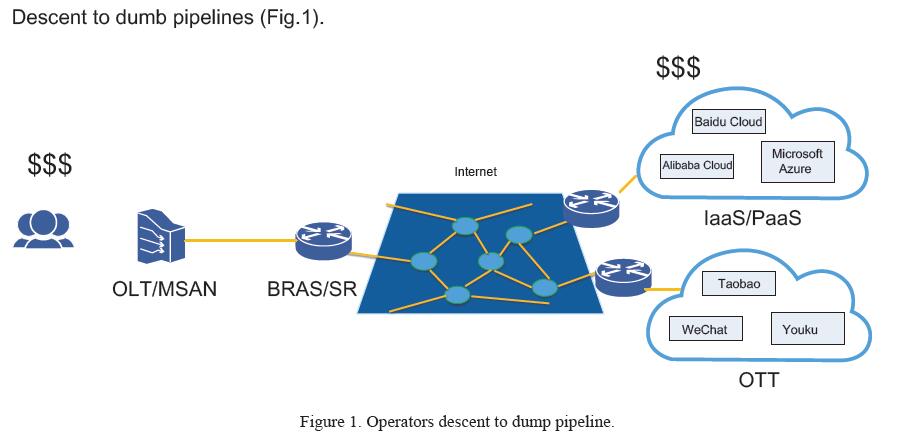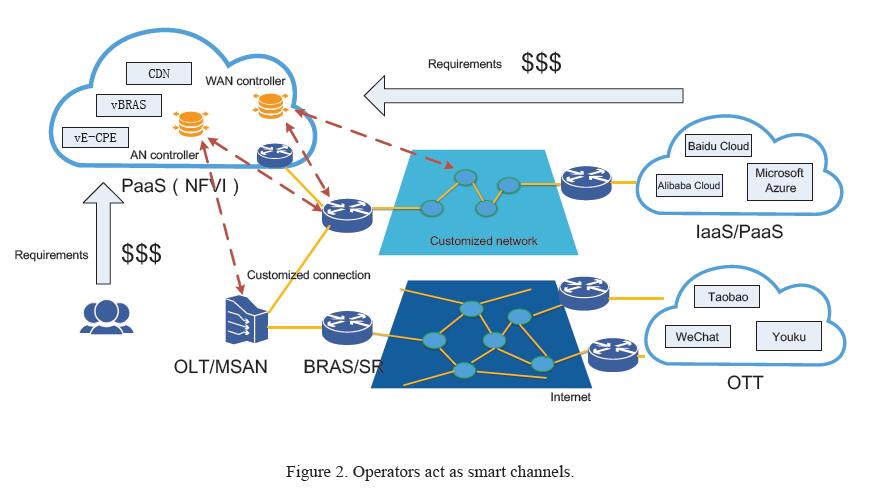Access Network Virtualization Enables Network Transformation
Virtualization is rapidly transferring the commercial value of networks from services provided by dedicated hardware to that delivered by software.
Internet companies are beneficiaries of virtualization. While they traditionally lease physical servers from internet data centers (IDCs) to develop services, their computing, storage and internal networks in data centers are now run through virtual infrastructure as a service (IaaS). Down the road, they will evolve towards the platform as a service (PaaS) model, which features integrated development and operation. With PaaS, services will be iterated and launched faster, and the ecosystem that integrates partners will become stronger.
Currently, incumbent operators still operate services including voice, IPTV, high speed internet (HSI) and enterprise VPN through private APIs or network management interfaces provided by dedicated equipment. Most of the operators’ IT systems, including B/OSSs, still run on physical servers in IDCs in a low intensive level.
The changeable and distinct demands of end users can be customized in the cloud of internet companies. On one hand, taking advantage of their head start in virtualization, internet companies direct massive connections to their cloud to create value. On the other hand, operators’ voice and IPTV services are challenged by OTTs. Operators’ revenue has no obvious growth as the internet traffic and connections exponentially grow.
The lag in virtualization puts operators at a disadvantage when they try to tap the commercial value of internet services. Even if operators wish to achieve a win-win with internet companies, they must accelerate their response to keep pace with internet companies and end users in providing new services.
To overcome challenges, operators have two choices:
● Descent to dumb pipelines (Fig.1). In this case, operators only reap revenue from ordinary internet connections. They can’t predict any changes in user experience or customize networks as required by users. For example, while a best-effort pipe is sufficient for internet access most of the time, bandwidth needs to be increased when users visit video sites. Videos can mostly be pushed to users through unicast transmission, but a customized multicast network ensures good user experience when major sports events are held.

● Be smart channels which satisfy ever-changing demands (Fig.2). Operators need to build PaaS-centric networks that can be fast orchestrated to tackle challenges. Mainstream operators have accepted the network functions virtualization (NFV) concept proposed by ETSI and are planning to build cloud-based data centers as their NFV infrastructure (NFVI).

Data centers based on PaaS platforms are similar to the service zones set along a highway in that they can readily provide differentiated services for network traffic. A large physical network that includes an access network and an IP WAN is abstracted and virtualized to the PaaS data center. A mirror of the network resources is established in a purely software-based virtual environment, where the network resources and functions can be programmed.
Internet companies and end users don’t have any physical WAN networks. In most cases, they can only use ordinary internet connections.
If operators possess capabilities for network virtualization, end users and internet companies can ask for network customization when some valuable connections are about to happen. In this way, they can acquire one-to-many connections, which have shorter delay, higher bandwidth, and lower cost than ordinary internet connections.
The control, separation and forwarding of SDN enable software functions to separate from dedicated hardware. Through the SDN controller, even physical network resources outside the data center can be mirrored in a software-based virtual environment to implement the VNF.
It differs from traditional VPNs, which neither support the mirroring function nor have any attached software that can clearly show how to customize VPN networks.
Access network virtualization consists of network virtualization and network functions virtualization.
● Network virtualization: the access network is cut into different slices, with each slice serving as a customized virtual network. A virtual network can be preconfigured with a long life cycle. Such virtual access networks can be wholesaled by basic operators to virtual operators. A virtual network can also be dynamically created and deleted to guarantee a good user experience. Such virtual networks can be low-delay and low-bandwidth to meet the requirement of industrial control, or they can be low-jitter and high-bandwidth to enable virtual reality (VR) applications. In this case, a physical access network can be shared by multiple virtual access networks.
● Network functions virtualization: virtualized network function (VNF) is a pure software function module. With the VNF, the development and verification functions are independent of dedicated hardware platforms; the computing and storing resources during actual operation are acquired from virtual platforms like x86, and network resources can be obtained from physical network connections. At this time, network traffic needs to be routed to the VNF for processing. In addition, the network resources obtained by the VNF can also be a mirror of the physical network established through SDN. In this case, the physical network is driven by SDN and the actual user traffic can go beyond the VNF.
There are five main components for access network virtualization as below:
● VFN components used for NFV: The VNF components include vOLTs, vBNGs and vCPEs, which are control- and management-plane software functions separated from the physical OLT, BNG and CPE respectively.
● NFVI platform where VNF runs: The NFVI is an IaaS or PaaS platform that is responsible for virtualizing physical computing, storage and network resources.
● Physical forwarding device controlled by NFVI: It consists of distributed OLTs, centralized NFVI-GW forwarding pools, and overlay networks in data centers.
● SDN controller: It consists at least of vDC controllers and AN controllers. While computing and storage resources are only centralized in data centers, network resources include both DC networks in data centers, and many network nodes and links that are outside of data centers. The vDC controller virtualizes overlay networks in the data center, and the AN controller virtualizes the access networks that connect users to the NFVI. All the VNFs control the direction of network traffic through SDN controllers.
● EMS: It is used to configure the network elements irrelevant to virtualization, such as physical nodes and links. All configurations are semi-permanent, constant in normal cases, and irrelevant to the orchestration of upper-layer services.
SDN extends network virtualization from data centers to outside. Although more and more traffic will occur horizontally in the data center or between data centers, a controlled access network is still required to dispatch vertical traffic to the respective data centers and traditional internet, and then flexibly process the traffic with diverse software.